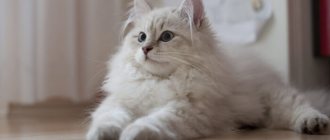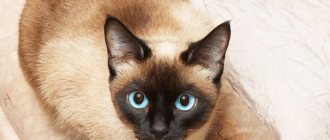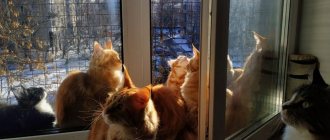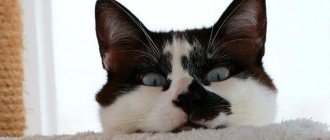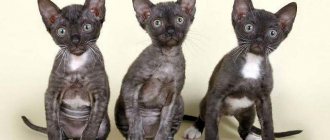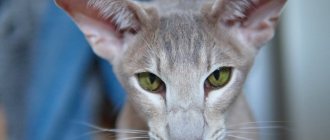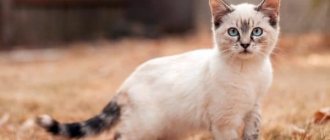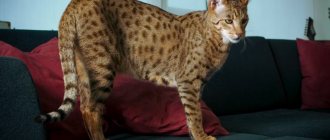Felines are a family of mammals belonging to the order Carnivora. Most often, they get their food by sneaking up and stalking it, sometimes by chasing it.
This family includes many animals, some of which, such as the Amur tiger, are impressive in size and weight. But there are also miniature animals whose weight does not exceed 1 kg.
The smallest wild cats in the world can live in different parts of the planet. But, unlike big cats, they give birth every year or more often, they can give birth to 5 to 6 cubs. This is the only thing that unites them, and their appearance, color, habits and lifestyle can differ significantly.
Each of them has its own unique character, although most eat rodents, are nocturnal and prefer solitude.
Jaguarundi
They are part of the Puma genus. They have an elongated body, particularly flexible, short but strong legs and a long, thin tail. In appearance, it is somewhat similar to a weasel. It is bright red or brown mixed with other shades.
The length of the jaguarundi is from 55 to 77 cm, plus a tail, which can grow up to 33-60 cm, height - from 25 to 35 cm. You can meet it in America. They live alone. They are terrestrial animals, especially active during the day, but they can climb trees.
They feed on small prey (up to 1 kg), everything they can catch. Sometimes they raid poultry houses, or eat green figs.
Kinkalow character traits
They paid attention to the appearance and recognized that it was quite original. Now let's figure out what kind of character is inherent in kinkalow.
Although this cat breed appeared quite recently, it is already possible to identify the characteristic features of its behavior. Kinkaloo kittens are friendly from the moment they begin to understand more or less something in this world. The cat's playfulness and good disposition last until old age.
Cats are good at making contact; they do not like to be without a person. However, they are in no hurry to impose themselves, especially if the owner is busy with something. But they can very well support the company, so the cat welcomes the attention of the household members.
The short stature of the breed is not an obstacle to active pastime. The cat climbs higher and watches with interest the lives of those below. Curiosity will make the fluffy even climb onto the closet if there is something interesting there.
The cat gets along well with other animals in the house due to its natural friendliness and curiosity. Cats also communicate well with children of any age; aggression is alien to them. If they don't like the situation, they get up and leave, switching to another object.
The Kinkalow cat is not particularly talkative. A quiet meow is heard when the animal talks about its hunger or other need.
Raising and training a pet
It has been noted that the Kinkalow cat is smart and inquisitive, which means that it can be trained to use a litter box and the rules of behavior in the house without any problems.
To keep the animal strong and happy, you can conduct lessons outside. This way the muscles will be in good shape, and the contact between the cat and the owner will always be established.
The pet walks calmly on a leash or harness, which is preferable to a free walk. We remember that the furry little paw does not show aggression, but other animals on the street can even behave unfriendly.
Energy and playfulness are adopted. You can watch with interest how the cat gets acquainted with the world of the street, studies crawling insects, and watches the birds.
global $ads_google; //data-ad-slot=”2475549904″ $ads_google = empty($ads_google) ? false : true; ?> if ($ads_google == false) {?>
$ads_google = true; ?> } ?>
forest cat
This small predator lives in Europe, as well as in Africa and Asia, which is also called the wild or European cat . He regularly hunts small animals and birds. Lives alone.
The forest cat is timid and tries to avoid people, often being aggressive.
These animals have brown fur with black stripes. They have a thick tail. Body size is forty-five to eighty centimeters, height is thirty-five centimeters, while the length of the tail is thirty centimeters. They weigh from three to eight kilograms. African subspecies are much smaller in size.
Iriomotean cat
This is a subspecies of the Bengal cat that lived on the small island of Iriomote, located near Taiwan. For a long time, the Iriomotean cat was considered a separate species. It was discovered in 1965.
The length of a cat with a tail is from seventy to ninety cm, and it makes up about 25% of its length. It weighs from three to five kg. It is dark brown in color, with small dark spots, which then merge into stripes. The animal prefers a nocturnal lifestyle, and during the day it hides in secluded corners. Prefers a solitary life. It feeds on rodents, waterfowl and crabs.
Now the number of these animals is rapidly declining, because... The meat of the Iriomotey cat is considered a delicacy among the local population. There are now less than 100 individuals.
Manul
Otocolobus manul comes from Greek words that can be translated as “dwarf ear.” cat is also called Pallas's cat , after the man who first described it in 1776. It was a naturalist from Germany P.S. Pallas.
In size, it resembles an ordinary cat: length - from 52 to 65 cm, and tail - from 23 to 31 cm. Pallas's cat weighs two to five kg. He has a thick and long tail, sideburns on his cheeks, and small and round ears.
Among the cats, the Pallas's cat is the fluffiest. The fur is gray, the fibers have white tips, which makes it seem like it is dusted with snow. There are narrow stripes. It can be seen in Asia, in steppe or semi-desert areas of the mountains.
It is active at night or early in the morning; during the day it sleeps in a shelter: in rocks or in old burrows. Eats rodents and pikas, sometimes larger prey. Pallas cats do not know how to run fast; they hide from enemies by climbing rocks and stones. Their numbers are rapidly declining.
Hygiene and care
Kinkalows are low maintenance. The coat of short-haired cats must be combed once every two weeks, and that of long-haired cats - once a week. Kinkaloo needs to be bathed 2-3 times a year. This does not cause difficulties, since the breed easily gets accustomed to water from a young age. After water treatments, your pet can be dried with either a towel or a warm hairdryer. It is important to know that kinkalows with light coats have increased sensitivity to ultraviolet radiation. Therefore, it is necessary to ensure that your pet does not stay in the sun for a long time and does not get sunburn on its body and curled ears.
Kinkaloo teeth need to be brushed once a week with a special toothbrush and toothpaste. If plaque is not removed in time, it can result in inflammation or tooth loss.
Through daily dental care, you can prevent the accumulation of plaque, the formation of tartar and caries, and also ensure fresh and clean breath for your pet.
Suitable grooming products
If you cannot find the right pet care product yourself, you can consult a specialist or read customer reviews on the Internet. Personal experience is often the best method of finding the necessary products that meet important criteria: reasonable price and high quality.
Photo gallery: the best products for caring for kinkalou
Shampoo for cats Perfect Coat has a pleasant smell, reduces stress during bathing and is suitable for both short-haired and long-haired cats Natural extracts of rose hips and St. John's wort added to Biovax shampoo have a wound-healing and tonic effect, and tea tree oil has a powerful antimicrobial effect Globalvet shampoo Dandruff normalizes the activity of the sebaceous glands, helps normalize the microflora on the animal's skin, relieves irritation after various zoohygienic procedures. The active components of Celandine shampoo help destroy parasites in pets' fur and prevent re-infection Mr. Dry shampoo. Gee is based on white clay, which absorbs excess oil and dirt from the coat, relieves inflammation and provides natural protection to the skin.
Cleaning ears and eyes
Kinkaloo ears should be cleaned of earwax once a month with a piece of cotton wool or a cotton swab. Eye cleaning involves removing accumulated tears from the corners of the eyes, which prevents the development of disease-causing organisms. In pet stores you can purchase special products for caring for your pet's eyes.
The lotion carefully removes eye clogging (dust, sand), relieves swelling and irritation of the eyelids, constant use of the lotion reduces the risk of diseases
Nail trimming
Domestic cats use household items to wear down their claws, as they cannot do this using tree bark. To avoid damage in the apartment, it is necessary to trim the nails. To do this, you will need nail clippers, trimmer scissors, or other tools suitable only for animals. During this procedure, only the tip of the claw is cut; the opaque layer at the base is not affected, since there are vessels with nerve endings there.
When trimming claws, only the light part of the claw is always trimmed with a frontal cut.
You should not trim nails if your pet is hungry or anxious: there is a high risk of damaging the nail if you move the tool carelessly. It is necessary to accustom the cat to the procedure gradually.
Anti-scratches are an alternative option for neutralizing your pet’s claws. These are safe silicone claw attachments that free the owner from the hassle of repairing damage to walls and furniture. Each pet reacts differently to such protection products, so to determine whether anti-scratch protection is suitable for your Kinkaloo, observe your pet’s behavior in the first days of use.
Anti-scratch pads of any color can be purchased at any pet store.
Castration and sterilization
Spaying or neutering should be done before the Kinkalow begins puberty, at approximately 8–18 months. Before the procedure, it is important to determine your tolerance to anesthesia, since the operation is performed under general anesthesia. After it, you need to carefully care for the animal for two days:
- On the first day it is forbidden to feed the pet, and on the second day you can already give food, but in small quantities.
- Give the kinkalow water and monitor its body temperature.
- During the postoperative period, keep the cat on the floor or low surfaces: coordination of movements will be impaired due to anesthesia, and the animal may be injured.
After Kinkalow surgery, care, attention and support are especially needed
The operation also affects the metabolism, and therefore the kinkalow's eating habits will have to change. Now the food should consist of specialized food for neutered cats.
Long-tailed cat
a long-tailed cat
lives in dense forests , which is also called margay . The length of its body is from sixty to eighty cm, plus a long tail (40 cm). It weighs from four to eight kg. She has a yellowish-brown coat that has dark ring-shaped spots on it.
Prefers solitude and emerges from its hiding place only at night. Eats rodents, birds, and small primates. This cat spends most of its life on branches. Long-tailed cats are now endangered. It is prohibited to catch or shoot them.
Munchkin – 3.6 kg
Munchkins are short-legged cats. The strangeness of the breed does not end there - cats can stand on their hind legs, resembling a kangaroo. It is believed that the breed began with Brambleclaw, a cat in Louisiana who was found under a van and adopted by kind owners. It was believed that her paws did not grow due to a difficult life on the street, but then it turned out that she had a genetic mutation. Thanks to which a new breed appeared. Munchkins were officially recognized only in 1991.
Kalimantan cat
Its other name is Borneo cat . She lives on the island of Kalimantan, which belongs to Malaysia and Indonesia. This is a rather rare and poorly studied species. The first whole animal was discovered in 1992, she fell into a trap. She was transported half-dead to the Sarawak State Museum.
It was only in 2002 that they were able to of a Kalimantan cat in the wild Her body length is 58 cm, she weighs from 2.3 to 4.5 kg.
Origin story
American cat breeder Terry Harris decided to experiment - crossing one of her Munchkin cats with a Curl cat. Soon the couple gave birth to unusual kittens with short legs and curled ears. For several years, Harris and other miniature cat lovers worked on a new breed and in 1997 it received official recognition from TICA as an experimental breed called the Kinkalow.
The breed probably got its name from two English words kink - “kink” and low - “low”.
Currently, the Kinkaloo is positioned as an experimental combination breed. It is still at the stage of formation and stabilization of characteristics.
Video about the Kinkalow cat breed:
Velvet cat
The velvet cat is one of the smallest: its body length is from 65 to 90 cm, but slightly less than half of this length (40%) is its tail. Its height is twenty-four to thirty cm, and it weighs from 2.1 to 3.4 kg; females are even smaller.
The velvet cat has thick fur, which can protect it from sub-zero temperatures. The color ranges from sand to gray, with brownish stripes on the back. Found in hot, dry areas: sandy deserts, rocky valleys.
They are especially active at night, and during the day they hide in abandoned burrows of other inhabitants of the area. They eat game, anyone they can catch. They may not drink for a long time.
Conclusions about the breed
There are many cat breeds in the world, and the Kinkaloo cat makes it onto the list with its cute mincing gait. It is necessary to summarize the selection work; quite a lot can already be said:
- The appearance of the Kinkalow cat breed is still being formed, but its characteristic features - ears, paws and soft fluffy fur have become a calling card and people like it.
- The nature of the cats is more than pleasant: there is no intrusiveness, although the pets are quite “affectionate”. The animal also cannot be called vocal, which for many seems a plus.
- While no genetic diseases have been identified, the furry's health is good.
- Kinkalows are not demanding in care; the main attention goes only to the fur coat.
- The breed's diet is prepared in the traditional way; no special diet is needed.
The wonderful heir of the American Curl and Munchkin gives the world his quiet purring and is waiting for him to have a loving person next to him!
Sumatran cat
The Sumatran cat Sumatra
, Borneo, etc. It is reddish-brown in color, with thick and soft fur, its chest and abdomen are white, there are brown spots on the sides, and 2 white stripes on the forehead.
This is a miniature animal, its length is from 53 to 81 cm, and its weight is from 1.8 to 2.7 kg. It feeds on frogs, fish, etc., living in the water. Sometimes poultry is stolen. They love fruits and dig up edible roots in the ground.
Nutrition
Kinkaloos are not prone to overeating, and therefore they need a standard, nutritious diet, free from restrictions. It should include natural products or ready-made food. It is important that your kinkalow's diet is appropriate for his activity level and age. During molting, you need to give vitamins for good condition of the coat, and during other periods, be sure to include mineral complexes in the diet. It is also important that your pet always has drinking water and crackers for his teeth. An adult kinkalow needs to be fed twice a day, and a kitten needs to be fed four times a day. Kittens aged 8–12 months are fed three times a day. The serving size is determined based on the pet’s weight and should not exceed 5% of it.
Cat food
Kinkaloo, like other active short-legged cats, is suitable for special premium and super-premium food, which provides cats with all the necessary macro- and microelements. Economy class food in this case will be an analogue of fast food.
Photo gallery: brands of food suitable for the Kinkaloo breed
This dry food formula is moderate in fat to help limit weight gain while maintaining protein, calcium and phosphorus intake for healthy growth. Contains a clinically proven antioxidant complex for a strong immune system, controlled sodium and phosphorus levels to support vital organ health and high quality ingredients for healthy and easy digestion B vitamins and iron in the food will help the cat stay active, prebiotics will support the functioning of the digestive system, and a special adapted nutrient profile will allow you to monitor optimal weight balance
Natural food
The natural diet of a baby Kinkalow is the same as that of an ordinary cat. You should remove from the menu foods that can harm sensitive digestion - salty, sweet, flour and smoked. Also, you should not feed kinkalow with food from your table: fatty meat, sharp bones, confectionery, raw fish, smoked meats and pickles.
In addition to natural foods containing vitamins, it is necessary to give your pet calcium to maintain strong bones.
Southern tiger cat
In 2013, the Southern tiger cat or Southern tigrina was recognized as a separate species. Lives in Brazil, Paraguay, Argentina, etc. Their body length is from 36.5 to 49 in females and from 44 to 55.5 cm, and their tail length is from 213 to 35 cm.
Males weigh from 1.91 kg to 2.42 kg, and females - from 1.3 to 2.21 kg. The Southern Tiger cat has a yellowish-brown coat that becomes lighter on the sides, and a white or light belly. It feeds on mice, birds, shrews, lizards, and sometimes hunts larger prey. Endangered.
Appearance
A distinctive feature of Skookums is their curly fur, short legs and a pronounced collar, which they inherited from the La-Perms.
Skookum cats are medium-sized, densely built, muscular, squat, powerful, rounded chest. The shoulders and hips are strong, the legs are short and very strong, the hind legs are slightly longer than the front legs.
Skookum can be either long-haired or short-haired, and the shorter the hair, the straighter it is. Long-haired representatives have a medium to long coat. The color can be any, but the mustache and eyebrows should be curly.
Spotted ginger cat
She belongs to the genus of Asian cats. It can be found in India and Sri Lanka. The rusty cat is endangered; there are only about 10 thousand adult individuals in the world. Its length is from thirty-five to forty-eight cm, and its tail is from fifteen to thirty cm. An adult cat of this breed weighs 0.9 -1.6 kg.
Externally, the Spotted Red cat resembles a Bengal; its coat is gray, but it has “rusty” spots. The belly is light. They lead a solitary lifestyle and go hunting at night. They feed on mice, lizards and various insects. They spend a lot of time on the ground, although they can climb trees.
These cats give birth to one to three cubs, but most often one baby is born. The number of these animals is constantly decreasing, because... their habitat changes.
0 0
Breed health
The breeder, who decided that the new breed should see the light of day, approached the matter responsibly: this is one of the healthiest cats. She is characterized by endurance and unpretentiousness. With proper care there are practically no problems. The care package includes a visit to the doctor, vaccination, and antiparasitic treatment.
A cat can get feline diseases, but he does not have genetic diseases. Even predispositions to them have not been identified. While this suggests that it is too early to draw conclusions, the breed is on its way to development. Therefore, owners should be careful and protect their cat from typical problems such as infections.
Congenital abnormalities include long legs in kittens and straight ears. They are also purchased, but such individuals are not allowed for breeding.
The usual lifespan of a kinkalow is 10-15 years.
. There are also long-livers among the charmers.
Few nurseries are currently breeding this rare breed. Almost all of them are in the United States. You can knit a pet with a kinkalow, an American curl and a munchkin. The first mating is allowed at the age of 1.5-2 years.
Pregnancy proceeds as usual, and after two months the offspring is born. Kittens are examined and babies with long legs are identified. They do not meet the standards and are sold cheaper due to the fact that they are not suitable for breeding.
